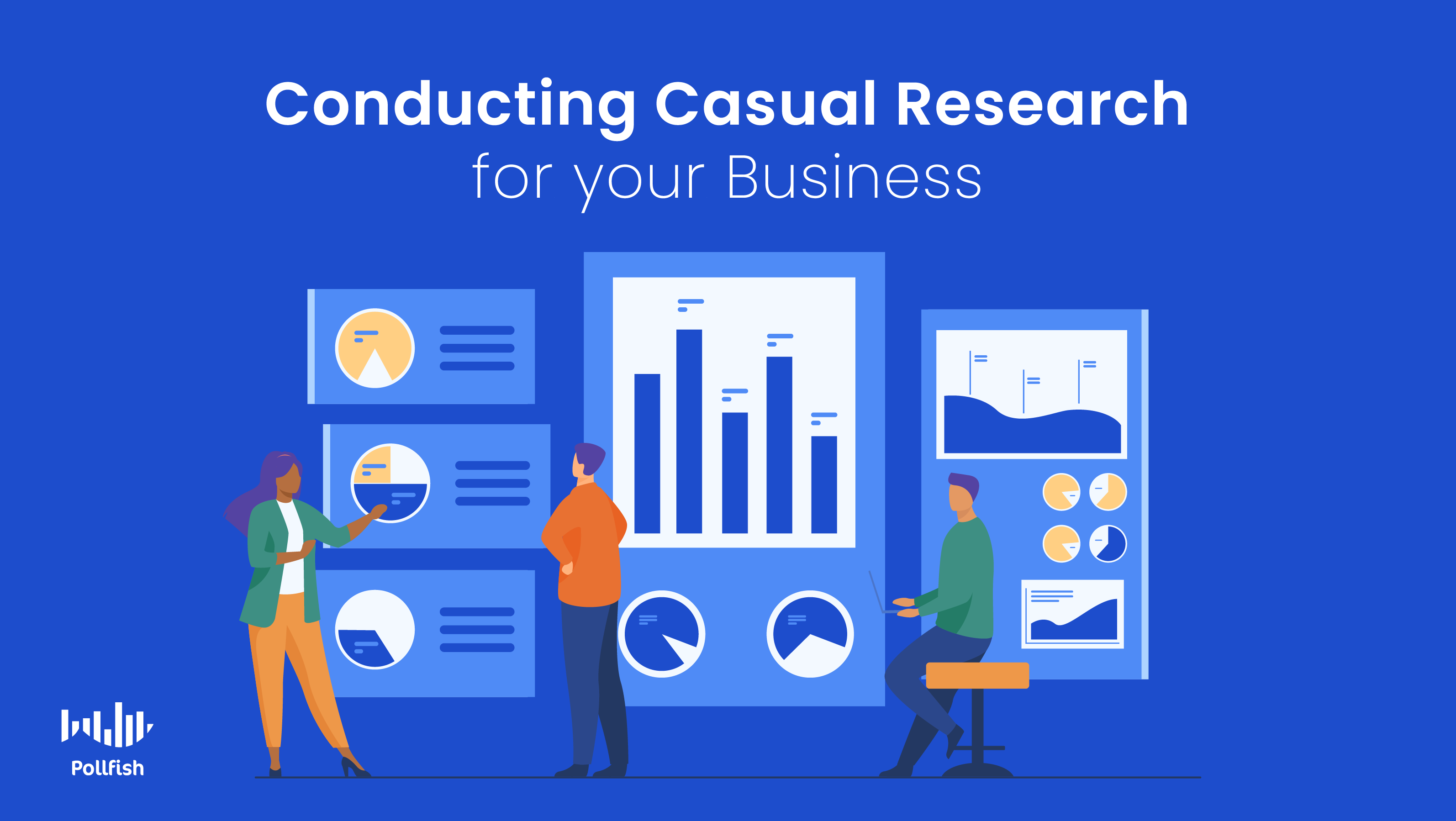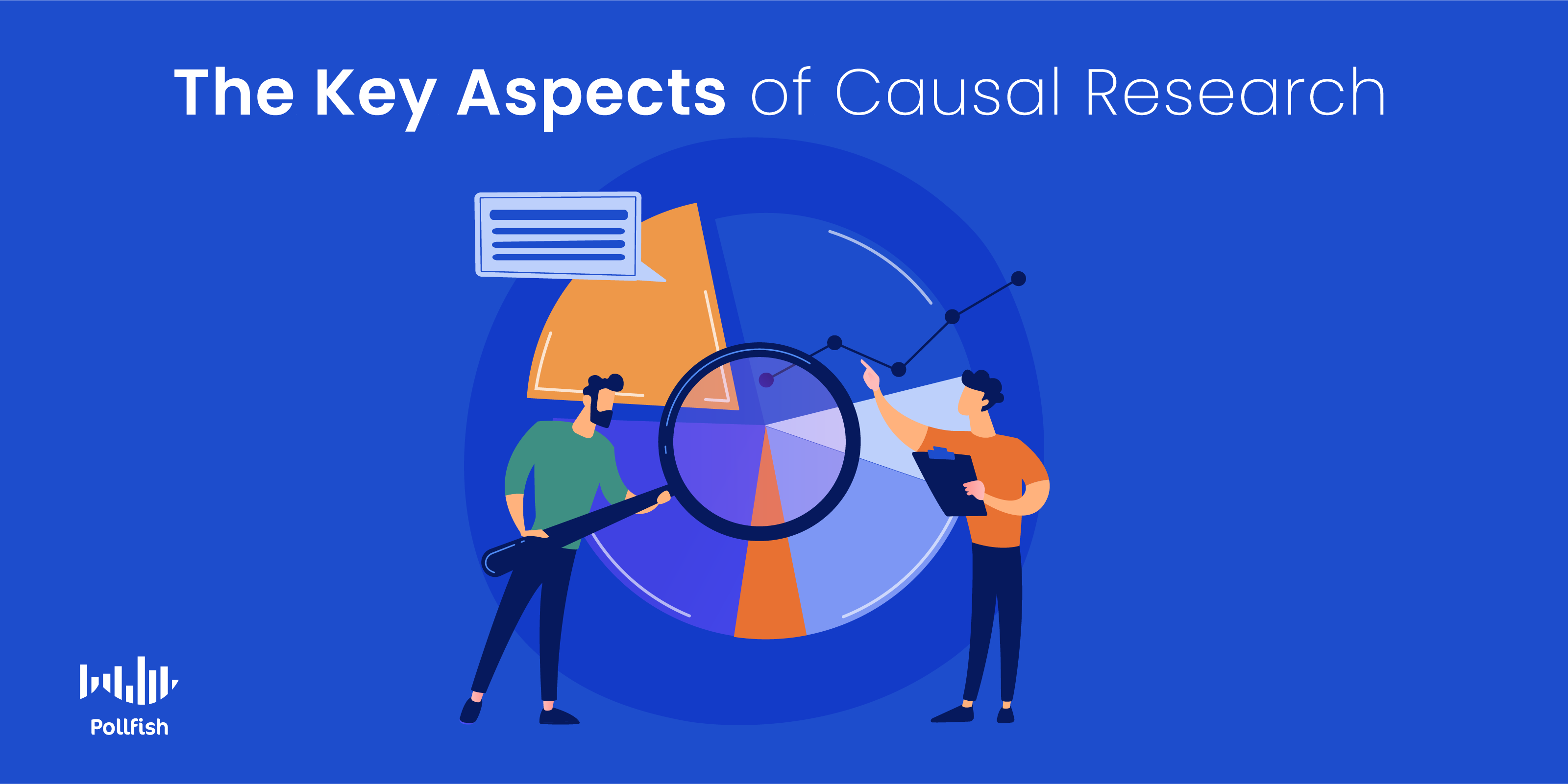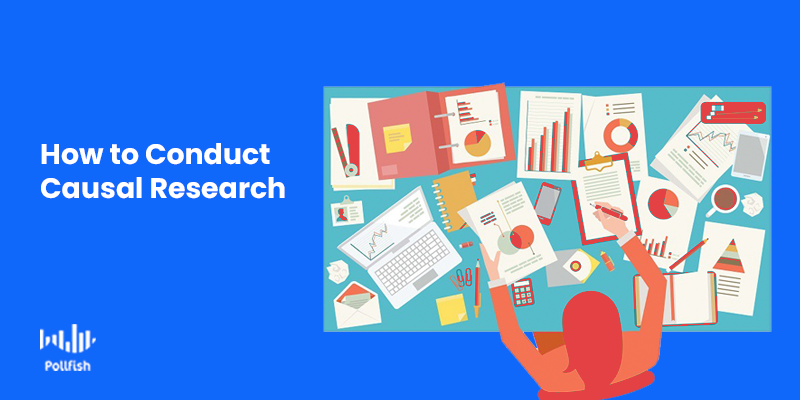Understanding Causal Research & Why It’s Important for Your Business

Causal research is one of the foremost kinds of research used with survey research. As such, it is employed across various verticals and can be implemented for any market research project.
Logically following correlational research and by following suit to it, it seeks to understand the relationship between variables — but it takes this pursuit further.
This is because causal research is chiefly involved with finding the cause and effect relationships between variables, as opposed to simply scouting their existence. Once researchers establish that a relationship between two variables exists, they ought to move to causal research to discover if and how they affect one another.
This article explains causal research in full detail, from what it is, to its importance, which surveys are most apt for it and more.
Defining Causal Research
Also called causal-comparative research, causal research seeks to find causal relationships, that is, cause and effect relationships between two or more variables.
Causal research is the latter form of an overall research process, as it follows after correlational research in the sequence of exploratory, descriptive and correlational research. This is because these research methods establish the details and aspects of the research process that lead up to causal research.
Although correlational research finds and explains the relationships between two variables, it does not prove that either of those variables causes the other to behave in some way or vice versa.
Causal research, on the other hand, has the capacity to determine whether one variable affects another variable.
As such, causal research carries two objectives, both of which are concerned with a possible causal relationship:
- Discovering which variables constitute the cause and which the effect.
- Establishing the relationship of the causal variables and their ensuing effect.
The Key Aspects of Causal Research

There are various characteristics that form causal research in addition to its two main objectives. Understanding these is key to deciding whether you need to perform this research, along with how to go about it.
The following enumerates the critical aspects of this kind of research:
- It entails discovering the existence of cause and effect relationships between two or more variables, via conducting experiments or testing markets in a controlled setting.
- It’s more scientific than exploratory and descriptive research.
- Market researchers conduct experiments, or test markets, in a controlled setting.
- Involves going beyond simply finding an association or correlation between the variables.
- Studies how a dependent variable is affected by independent variables.
- To convey causality, the variable relationship is framed as: If A happens, then B will take place/ happen.
- It uses a directional hypothesis, in which one (or a set of) independent variables affect another set of variables, known as dependent variables, in a particular manner.
- The studies help researchers understand both the course of the relationship of the variables and its forecasted effects.
- It produces quantitative research and is methodically planned, designed, and formatted,
- It yields statistically conclusive data. The objective of causal research is to test hypotheses about cause-and-effect relationships
Why Your Business Needs Causal Research
With causal research, market researchers can predict hypothetical occurrences and outcomes. This allows a business to create a business plan most beneficial to the company.
Causal research offers an advantage for businesses in that, learning how one variable impacts another helps predict the effects of all kinds of business matters in cause and effect relationships.
This allows companies to inspect and analyze a business strategy before launching it. As such, understanding the causal relationships before enacting this strategy ensures that companies avoid ineffective and costly campaigns.
Additionally, it helps companies discover the variable relationships with favorable outcomes for businesses, empowering them to make educated changes.
Causal research is necessary, as it uses pre-existing data to unearth relationships. This helps find causative variables from a period of time. For example, brands can look into how weather patterns affected in-store versus online shopping from several months ago. They can then compare it to current weather conditions and behaviors.
This particular study helps establish a forecast on how similar weather situations will affect the two forms of shopping.
The causal relationships discovered in this study show businesses how to prepare for certain weather conditions and which form of shopping — digital versus in-store is most auspicious for revenue and which one tends to lag.
Understanding the causal relationships in this scenario allows businesses to better plan for each situation, along with avoiding certain efforts in response.
There are many other independent or predictor variables that can take hold on dependent, aka, response variables in the business realm. In this sector specifically, these are some of the key independent and dependent variables:
Key Independent Variables
- Prices
- Digital user experience (DX) such as new site features
- Advertisements
- Marketing activity (SEO, SEM, social media announcements, retargeting, etc.)
- Season
- Inventory (new products or upgrades)
- Interactions with sales agents
Key Dependent variables (which businesses depend on to be in their favor):
- Sales
- Demand
- VoC feedback (whether positive or negative)
- Site traffic
- In-store visits
- Revenue
- Time spent on a website, bounce rates, etc.
An Example of Causal Research for Business
The previous section included an example of how a business can use causal research to their advantage. There are plenty of other instances that require conducting causal research. The following is another example of causal research in business.
For example, to consolidate its fashion market research, an apparel brand considers studying its own business. Specifically, it seeks to determine and measure the impact of changing the color of a signature product.
Let’s say, the brand carries a signature black faux leather jacket and wants to measure the impact of changing its color to beige. The research obtained in this causal study would prove whether or not changing the color on a major product would affect its sales.
Other forms of businesses, including B2B businesses, can follow suit in their causal research, studying any of the independent variables aforementioned and how they affect the dependent variables.
Causal Research Survey Examples
There are various types of surveys you can use in causal research, however, surveys themselves do not prove causality. Causal research is largely dependent on conducting experiments. It is through these experiments that the research can deduce a cause and effect.
Nonetheless, here are some of the survey types to include in your research campaign.
To really connect the dots between cause and effect, we needed to create an experiment. This would include different renditions of the marketing collaterals, different markets, customers at different stages in the purchase cycle, and actions taken by competitors.
- The quantitative survey
- Discovers the aspects of statistical significance within variables.
- Helpful in that causal research is quantitative in essence.
- The retrospective survey
- Delves into past events, occurrences and attitudes in regards to the variables.
- Shows whether the variables changed and how so.
- The prospective survey
- Can find causative elements between variables over a period of time.
- Useful for studying variables to form predictions and understand outcomes.
- The customer experience survey
- Helps businesses zero in on variables that contribute to or result from certain kinds of customer experiences.
- Allows businesses to test CX in relation to the responses from this survey.
- The pulse survey
- Measures various matters critical in a business or organization; surveys employees.
- Deployed more frequently, so variables can always be continually tracked.
- The customer satisfaction survey
- Especially useful when bringing new products/services into the market to compare them with previous ones.
- Features 4 subtypes of unique surveys.
How Causal Research Differs from Correlational, Exploratory and Experimental Research
Causal research shares some similarities with some of the other major forms of research, most notably, with correlational and experimental research; however, it is significantly disparate.
Regarding its comparisons to correlational research, while both forms of research study the relationships between variables, causal research goes beyond finding the relationships between variables. It involves uncovering which variable serves as the causal agent (the independent variable) while which is the one being affected (the dependent one).
As such, it involves conducting experiments that manipulate variables in a controlled environment. On the contrary, correlational research does not apply any alterations or conditioning to variables. Instead, it is a purely observational research method.
It detects whether there is a correlation between only 2 variables, whereas causal research can study several at a time. Correlational research can determine that there is no correlation, a positive one or a negative one, yet these relationships do not mean that one variable affects another.
Exploratory research is vastly different from correlational research, as it forms the very foundation of a research problem and establishes a hypothesis for further research. As such, it is conducted as the very first kind of research around a new topic and does not fixate on variables.
Descriptive research, like exploratory research and unlike causal research is conducted early on in the entire research process, following exploratory research. Like exploratory research, it seeks to paint a picture of a problem or phenomenon, as it zeros in an already-established issue and delves further, in pursuit of all the details and conditions surrounding it.
Descriptive research, unlike causal research, only observes; as such, it does not manipulate variables or involve using a control group. It is also not as focused on variables as is causal research; it can be used to inspect and understand various components of research issues.
Experimental research, despite its comparisons with causal research, varies significantly from it. This form of research is propelled by way of a hypothesis, which is used to convey an expected relation between 2 more variables. It implements a scientific research design in which variables are measured, calculated and then compared.
Some research designs employ no manipulation of independent variables and these are used after the effect is uncovered.
While it is primarily concerned with an experiment to confirm a hypothesis, causal research seeks to find whether one variable affects another and how so.
The Advantages and Disadvantages of Causal Research
Causal research offers several benefits for researchers and businesses. However, as with all other research methods, it too carries a few disadvantages that researchers should understand.
The Advantages
- Allows researchers to determine whether the statistical relationship between the two variables found in correlational research has a cause and effect connection
- The ability to delve into more than 2 variables and make predictions.
- Can identify the reasons behind various processes.
- The ability to assess the impacts of changes on existing occurrences, processes, phenomena, etc.
- Can prove or disprove a hypothesis as well as drive the research needed for broadly experimental research.
- Carries the advantages of replication if it is necessary for the studies.
- The systematic selection of subjects gives way to greater levels of internal validation.
- Avoids confusion, as it requires testing all the variables that may be influencing the dependent variables to derive accurate results.
- Finds the causes behind relationships in variables, which attains the gap in correlational research.
- It is considered conclusive research, thus requiring little to no follow-up research or experimentation.
The Disadvantages
- It can fall prey to coincidences, in which similar such relationships and results don’t occur again.
- It takes a while to complete and can be expensive.
- It is difficult to find conclusions due to the impact of a wide scope of factors and variables present in a particular environment.
- Casuality can be inferred, but cannot be proved with 100% certainty.
- It is subject to contamination (influences from variables that are not studied).
How to Conduct Causal Research
Causal research is often the final form of research conducted in the research process and is considered conclusive research. Therefore, it is of utmost importance to plan the research with strict parameters and objectives.
You must clearly lay out what you are trying to prove to avoid bias and dubiousness. Use the findings in exploratory, descriptive and correlational research to enter into the causal research stage.
The objective in this form of research is to unveil the variable that is causing a behavior or phenomenon — the cause, along with the ensuing behavior/phenomenon itself — the effect.
This research reveals which variable is which, along with the direction of the relationship between the variables and their predicted effects.

Here are the steps in conducting causal research:
- Find the purpose of the study.
- Ask a question to guide the study.
- Lay down a hypothesis, i.e., the outcome you expect.
- Find the support of the hypothesis.
- You can gather this conclusion as the following: if one thing happens, another will occur as a result. This requires three critical things to occur.
- Temporal Sequence: The cause must take place before the effect. NOt all correlations will clearly point to this, as the suspected effect may occur before the cause and thereby be unrelated to a cause and effect relationship.
- Concomitant Variation: When the cause changes, there should also be a change in the effect. Ex: If a brand’s ad spend is cut and sales plummet, you can expect the cause behind reduced sales comes from the reduction in ad spending.
- Ending Spurious Correlations: Refers to a common misinterpretation of cause and effect and happens when something thought to be the cause of an effect is actually caused by another variable (unconsidered).
- Conduct the experiment in a controlled setting.
- Manipulate the independent variable(s) to find their effect on the suspected dependent variables.
- Use a control, an independent variable that you don’t manipulate to use as a point of comparison between manipulated and non-manipulated variables.
- Jot down all changes you find within the manipulated and controlled variables, along with the changes in relation to the dependent variables.
- Conduct surveys to add more depth to your research, as they can find certain causes and effects or confirm the findings in your experiment.
Using Causal Research and Going Further
To summarise, causal research allows businesses to understand how current actions and behaviors now will affect it in the future by identifying the cause and effect relationship between variables. This is extremely beneficial for a variety of matters in the business world.
This research can determine the effectiveness of various marketing initiatives, campaigns and collaterals, along with virtually all other changes in a business, such as address change, introducing a new product, offering different promotions and more.
Given the prowess of forming predictions that causal research offers, businesses can use the insights beyond understanding cause and effect. It can form future marketing and advertising strategies, along with testing new ideas that relate or involve the variables from the research.
Although surveys don’t make up the entirety or even the majority of causal research, they can bolster any hypothesis or suspected course of action. As a business, you ought to employ them via a strong online survey platform that allows you to set up numerous surveys and survey campaigns.
Do you want to distribute your survey? Pollfish offers you access to millions of targeted consumers to get survey responses from $0.95 per complete. Launch your survey today.
